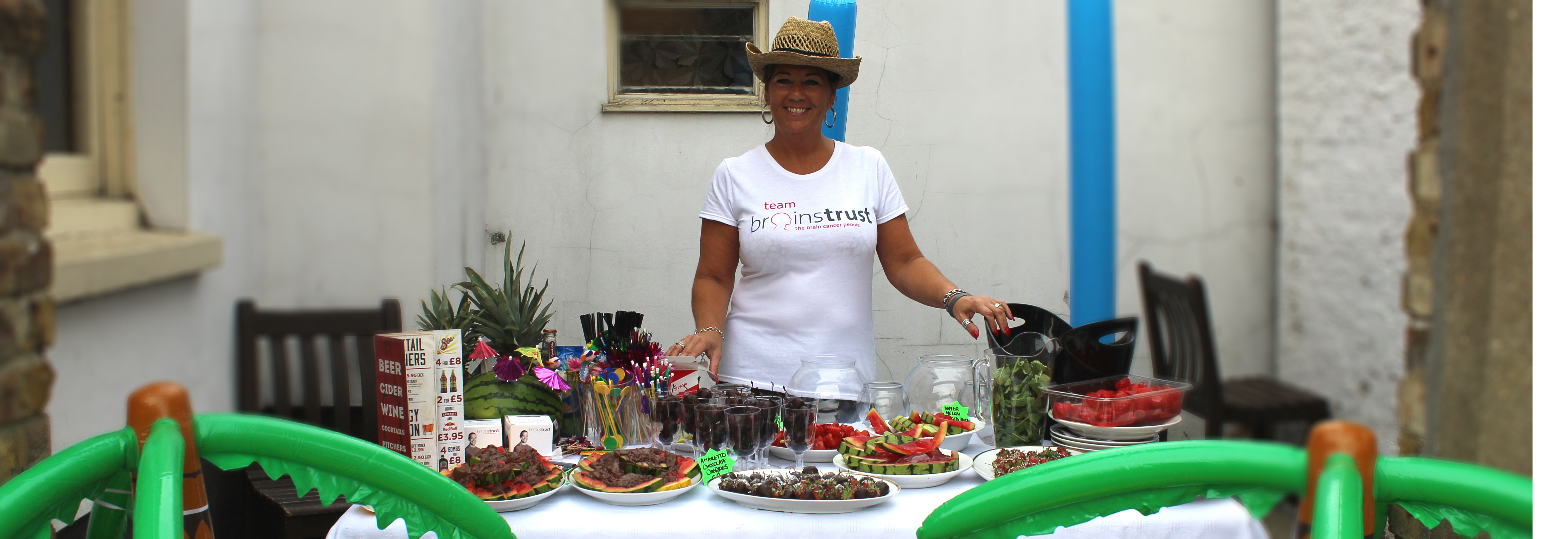
One of our lovely supporters, Sharon Springall decided to mark the end of summer a few months back by putting on a fundraising Music Festival to raise money for our support service.
Sharon, from Essex, was diagnosed with a left cavernous sinus meningioma in 2010 following cerebral oedema and required six months off of work to recover.
“The shock and horror of the diagnosis had a huge impact on me and my family, so I went into denial and threw myself into my work, only to suffer further on August 2012 when I collapsed at work and following a visit to A&E by ambulance, I was diagnosed with aseptic meningitis secondary to the meningioma. I was seriously ill for a further eight months and the effect that this had on me mentally and physically has been life changing. I had to concede and give up my job a year later following an unsuccessful phased return to work, as I was unable to cope mentally & physically. I have since then been diagnosed with chronic pain, chronic fatigue and now suffer from spondylosis potentially due to nerve damage caused by the inflammation of the meninges”
“Since leaving work, I have struggled to ‘rest’ and also come to terms with how this has changed my life. I found myself feeling lonely at times and felt that I needed to ‘offload’ on someone. I decided to organise a charity event, and following a very successful day found myself doing another. It was during this time that I discovered brainstrust. I sent an email to and within days had received a fantastic response. Immediately I felt as though I had found another friend. I found I was able to put all my feelings, whether it be sadness, frustration or anger into an email and feel as though someone was happy to listen and totally understood my illness and its effects. I was sent my ‘brain box’ which I found a fantastic help, and also found my husband reading the book and information leaflets, as he has found the whole thing quite hard to deal with.”
It was after being supported by brainstrust that Sharon decided to give something back. And she went all out.
“Following organising quite successful charity events, our local pub offered to support me in organising another. It was then I made the decision that I wanted to fundraise for brainstrust. I wanted to do something to support the charity, as they have and are supporting many people who have been diagnosed with a brain tumour and if it can help someone like me in feeling that I do have someone to speak to and turn to if needed then they deserve our support.

“I decided to organise a ‘Summer Music Festival’ marking the end of summer and the last bank holiday as a theme. In conjunction with the pub, we organised 7 bands/singers throughout the day. I then introduced the ‘summer’ theme with decorations and lights, organised a graphic designer for the poster and advertising and secured the free printing of the posters. I then visited as many local businesses in the village requesting their support by offering something as a raffle prize. Keeping to my theme, I also set up a small cocktail bar in the patio area and sold ‘Mojitos’ and ‘Sol Sunset Crush’ along with watermelons infused with vodka, maraschino cherries soaked in Amaretto and dipped in chocolate, and strawberries with tequila and triple sec jelly served with limes. I also added an inflatable limbo set and giant playing cards to add a bit of fun.”
“I am happy to say it was a hugely successful day and it was great fun seeing it all come together. I worked hard to pull off the day and am delighted that so many people attended and embraced the theme. We managed to raise awareness of brain tumours, so was worth it just for that reason. I spent a lot of time talking to people about brainstrust and the work they do and I felt that I could engage with them more when I spoke to them as someone who is living with a brain tumour.”
In total, Sharon’s Musical Festival went on to raise an incredible £807 for our support service. And she’s not stopping there.
“I am now already planning my next event for 2016, a football tournament in support of brainstrust- dates yet to be set as I am up against the Euro 2016 finals! In the meantime I am still working on a sponsored event called ‘Ditch the Device’ something me and my niece have thought up and are hoping to engage the local schools into, participating now they are all back to school.”
“A huge thank you to brainstrust for the amazing work you do and all the support you give to so many who find themselves devastated by the news that they have a brain tumour, and in raising awareness of this awful disease.”
It’s us who would like to thank you Sharon. You’re amazing.
Your money will help us support more people to feel less alone in the face of a terrifying brain tumour diagnosis.

If you, like Sharon, would like to do something big for brainstrust, so that we can support more people in the UK to feel less afraid, less alone and more in control in the face of a terrifying brain tumour diagnosis, then we’ll help you with it every step of the way. Visit our team brainstrust page to pick one of our challenges or simply get in touch with tessa@brainstrust.org.uk if you’d like to plan one of your own.



